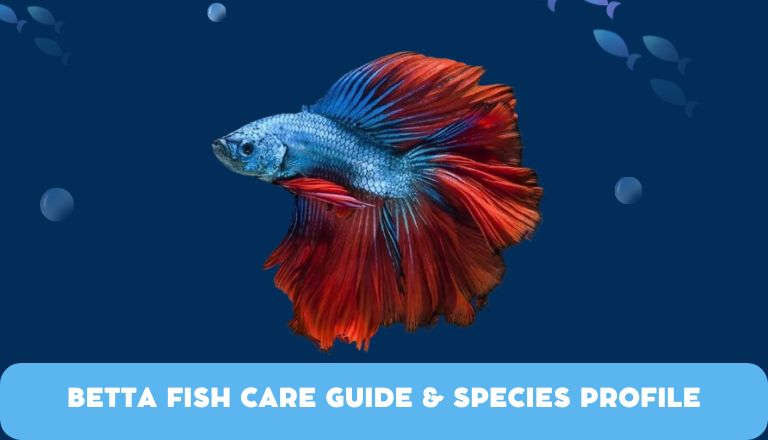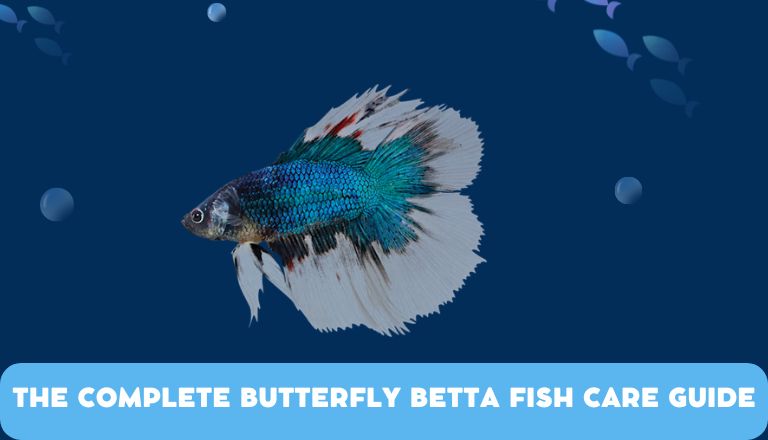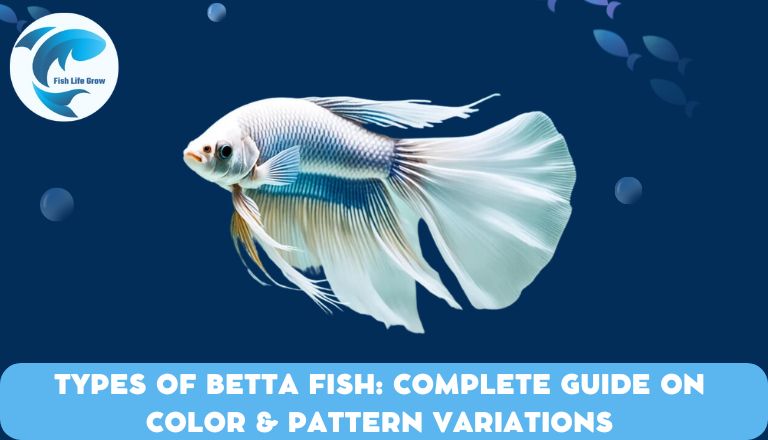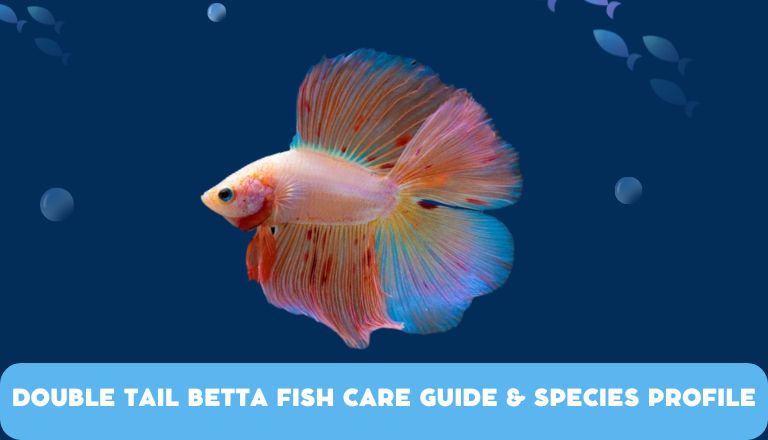Betta Fish Care Guide & Species Profile
Are you looking to add vibrant color and personality to your aquarium? Look no further than the Betta fish, also known as Siamese fighting fish. Aquatic fans love these beautiful creatures for their colorful scales and special fin shapes.
In this comprehensive Betta Fish Care Guide, We will talk about these interesting fish, give you tips on how to care for them, and talk about their behavior and where they like to live.
If you’re new to keeping a Betta fish, this guide will help you set up a healthy underwater home for your pet. Join us on this journey as we uncover the beauty and complexity of these mesmerizing aquatic creatures.
Betta Fish Facts & Overview
Betta fish are small and stunning freshwater fish known for their vibrant colors and long-flowing fins. These fish are popular for their unique personalities and low maintenance requirements.

Regarding care, bettas require a suitable aquarium environment with plenty of hiding spots and minimal water flow. Their labyrinth organ helps them breathe air at the surface, so they can live in water with low oxygen levels. Owning a betta fish is a rewarding experience for people who like their beauty and unique behaviors.
Origin
Betta fish originate from the shallow waters of Southeast Asia. These brightly colored fish come from places like Thailand, Cambodia, Vietnam, and Malaysia.
Their territorial nature is attributed to their natural habitat where competition for resources is high. Male betta fish are aggressive towards each other due to their evolutionary history.
Betta fish have a rich history and interesting features that make them fascinating to both experienced and new fish enthusiasts. Knowing where they come from helps us better understand and enjoy these beautiful and complex creatures.
Adult Betta Fish Size & Lifespan
Adult male bettas reach a size of around 2.5 to 3 inches in length, while female bettas are slightly smaller. These small fish are very territorial and popular with aquarium owners who want a visually striking centerpiece.
Healthy betta fish live for 3-5 years. Factors such as water quality, nutrition, and overall tank conditions influence the longevity of these beautiful fish. With proper Betta Fish care and attention, your betta brings joy for several years in your aquatic habitat.
Availability
Betta fish are available in pet stores, online retailers, and in some local breeders. The availability of Betta fish provides opportunities for aquarists to enjoy these captivating creatures.
Betta Fish Behavior & Appearance
Betta fish exhibit fascinating behaviors that captivate aquarists worldwide. Bettas are usually kept alone or with calm tank mates because they are aggressive. Watching a betta is interesting and teaches aquarists about their behavior.
Each betta fish looks different because of its color and fin shape. Their vibrant colors and flowing fins make them a popular choice for aquarium enthusiasts
Colors, Patterns, Fins, and Sex Differences
Betta fish are known for their wide range of shades including red, blue, purple, and white. These colors can be influenced by factors such as genetics, diet, water quality, and stress levels. Betta fish have beautiful and colorful fins.
Betta fish have cool patterns on their fins, like stripes, spots, or fancy designs. Some bettas have interesting patterns like marble or dragon scales, making them more captivating. These patterns make each Betta fish special and fun to watch.
Male Bettas display more vibrant colors and longer fins compared to females. Males have long flowing tails whereas females’ fins are shorter and more rounded.
Typical Behavior
Betta fish can be aggressive, especially male bettas, who fight if kept together. When a male betta sees another male in its space, it shows off its fins to scare the other fish. Betta fish have unique personalities, some are friendly and curious and others prefer to be alone. They are smart and recognize their owners.
Bettas are special fish with a unique organ that lets them breathe air from the water’s surface. This helps them live in places with low oxygen.
Are Bettas Easy To Take Care Of?
Bettas are small and need a good-sized tank with a filter and regular water changes to stay healthy.
Feeding your betta a mix of pellets, frozen, or live foods prevents health issues and makes your betta happy.
By providing the right environment and diet, bettas are easy to take care of and make wonderful pets for both beginners and experienced fishkeepers alike.
Betta Fish Care & Tank Requirements
To keep Betta fish healthy, provide proper betta care and the right tank setup. They thrive in warm water.

Don’t overcrowd the tank with decorations. This will help the bettas access the surface easily. Feed them high-quality pellets or flakes made for bettas. Feed them small amounts twice a day to avoid health issues.
Habitat and Tank Requirements
When setting up a habitat for your Betta fish, start with a tank size of at least 5 gallons to provide enough space for swimming and adequate water volume for temperature stability. Choose tanks with horizontal not vertical dimensions to accommodate Betta’s swimming habits.
Decorate the tank with live or silk plants to create hiding spots and resting places for the fish.
Maintain the water temperature between 75-82°F (24-28°C) and use a heater because Betta fish require warm water to thrive.
Keep the tank clean by changing the water regularly about 25% every week for good water quality.
Choose a gentle filter for your Betta fish to avoid strong currents that can harm their delicate fins.
Betta Water Parameters
Maintaining the right water parameters for the health and well-being of Betta fish. These vibrant creatures thrive in slightly acidic water with a pH level of 6.5 to 7.5. Keep ammonia and nitrite levels at zero, as any spikes in these toxins can be detrimental to your Betta’s health.
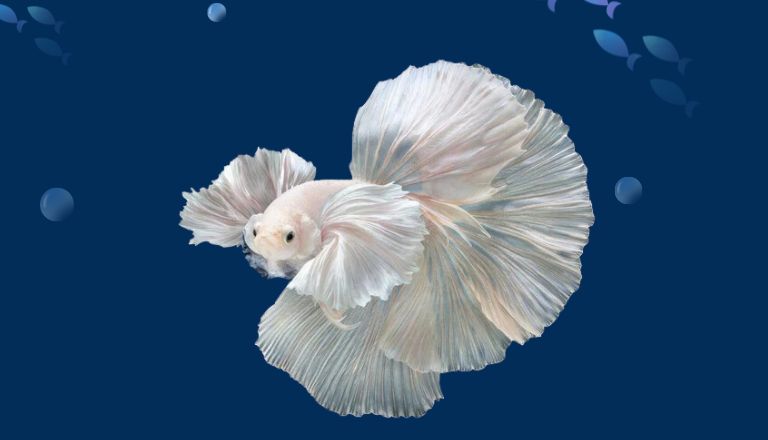
Keep the water temperature between 78-80 degrees Fahrenheit, as this mimics their natural habitat and promotes optimal health. Regularly monitor these parameters to ensure a thriving environment for your Betta fish. Even small changes in water parameters can have a significant impact on your Betta fish’s well-being.
Betta Fish Diseases
They get sick easily and die if not treated quickly. One common ailment is fin rot, caused by bacteria or fungi infecting the fish’s delicate fin tissues. Symptoms include ragged edges on fins and lethargic behavior.
Ich is a disease in betta fish. It causes small white spots on the fish’s body and fins. This tiny parasite easily spreads in a tank if not treated quickly. To keep your fish healthy, keep the water clean and maintain good hygiene in the tank.
Watch your betta fish closely for any signs of sickness. If you notice any problems, separate the sick fish and give them the right medicine.
Betta Fish Tank Mates
When choosing tank mates for your betta fish, consider their temperament and compatibility. Suitable tank mates for bettas include peaceful fish that are not aggressive or fin nippers, such as Neon tetras, Corydoras catfish, and Ghost shrimp. These species coexist peacefully with bettas in the same tank without causing stress or harm.

Avoid aggressive or territorial fish like Gouramis, Barbs, and certain types of cichlids as tank mates for bettas. These species attack bettas due to their similar territorial nature. Male betta fish are very aggressive towards each other, so don’t put them in the same tank. Choose tank mates carefully to make a peaceful environment for your betta fish.
Diet and Feeding
These vibrant creatures are carnivores and require a protein-rich diet to thrive. They can eat commercial Betta pellets, and live or frozen foods like bloodworms or brine shrimp that provide nutrients and prevent dietary deficiencies.
Overfeeding your Betta fish leads to various health issues like bloating and constipation. Their stomach is about the size of their eye, so feed them small portions multiple times a day.
Observe how much your pet eats to figure out the right amount of food to give them for good health and long life.
Breeding
Breeding Betta fish is a process that requires careful planning and attention. The first step is selecting a healthy pair of Bettas. Next, introduce the male and female bettas in a separate breeding tank and provide plenty of hiding spots for the female. The male begins to build a bubble nest at the water’s surface to prepare for spawning.
When the male fish finishes building the bubble nest, he will show off his fins and bright colors to get the female fish’s attention. The female fish shows vertical stripes when she is ready to lay eggs.
During spawning, the male fish holds the female under his bubble nest and releases sperm and eggs at the same time.
After spawning, carefully remove the female from the tank to prevent any aggression from the male toward her or their offspring.
As time goes by, you will see small fish swimming near the water’s surface with their yolk sacs. Feed them food like infusoria or baby brine shrimp for their growth and development.
As the fry grows, you see variations in color and fin types. Each fry inherits unique traits from their parents. Breeding betta fish is rewarding and needs patience, observation, and dedication at every stage.
Conclusion
Betta fish requires attention such as water temperature, tank size, and proper diet. These fish are popular pets for aquarium lovers because they are territorial and have unique personalities. Provide a suitable environment with hiding spots and change the water regularly for their well-being. Follow this Betta Fish care guide to create a healthy habitat for your Betta fish.
FAQs
How Many Bettas Should Be Kept Together?
Bettas are territorial fish and should be kept in separate tanks. Male bettas fight when kept together. Female bettas live together in a larger tank with places to hide to reduce fighting. It’s best to have one betta fish in a tank to keep them happy and avoid fights.
Are Betta Fish Easy to Take Care Of?
Yes, betta fish are relatively easy to take care of compared to other types of fish. Betta fish need a clean tank with good filtration, warm water, and regular feeding. With proper care, betta fish make great pets for both new and experienced fish owners.
How Long do Betta FishLive in a 1 Gallon Tank?
Betta fish can live in a 1-gallon tank, but it is not ideal for their long-term health and well-being.
In a 1-gallon tank, betta fish live for around 2-3 years with proper betta care and maintenance. Betta fish live for over 5 years in big tanks with clean water and things to keep them entertained.
How to Take Care of a Betta Fish?
To care for a betta fish, you need a tank that is at least 2.5 gallons in size. Keep the water temperature between 75-80 F and use a filter to keep it clean. Feed your betta fish high-quality pellets or frozen foods in small portions twice a day. Test the water quality regularly and change some of the water every week. Don’t put bettas with aggressive tank mates and give them hiding spots and things to explore in their tank.

